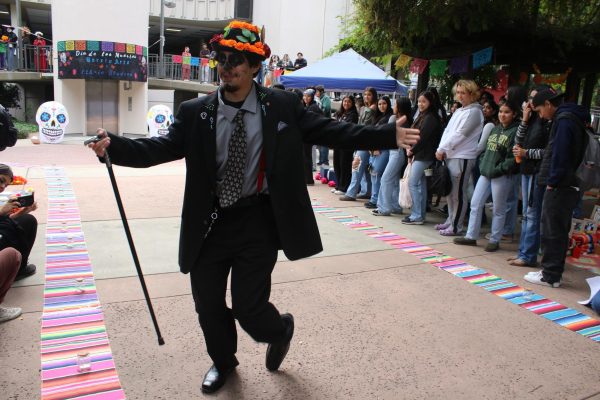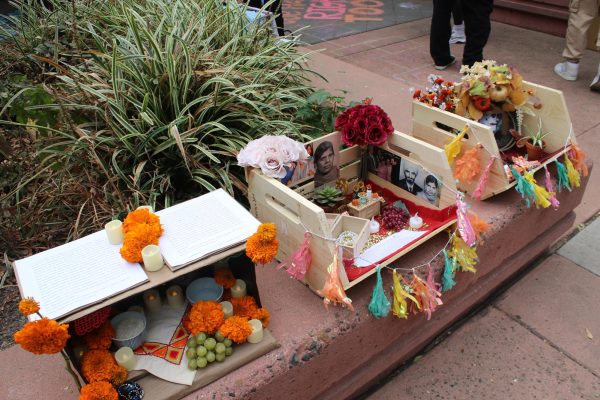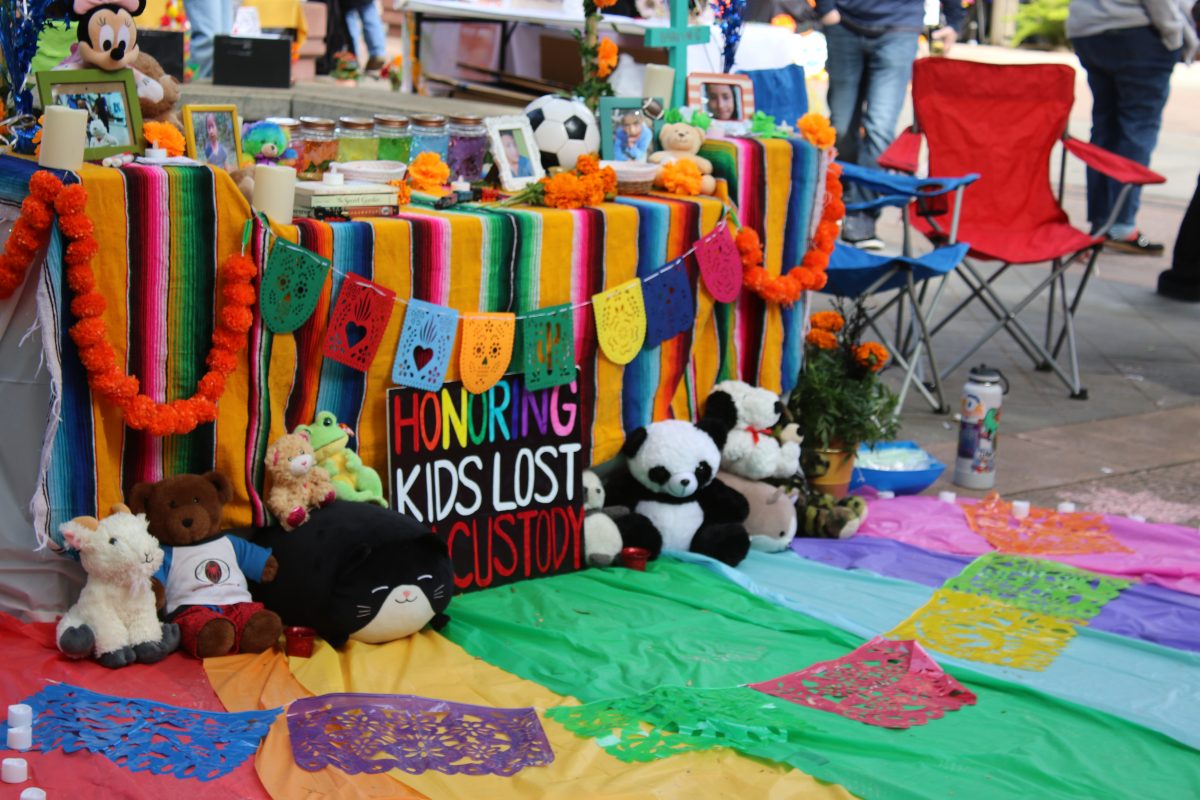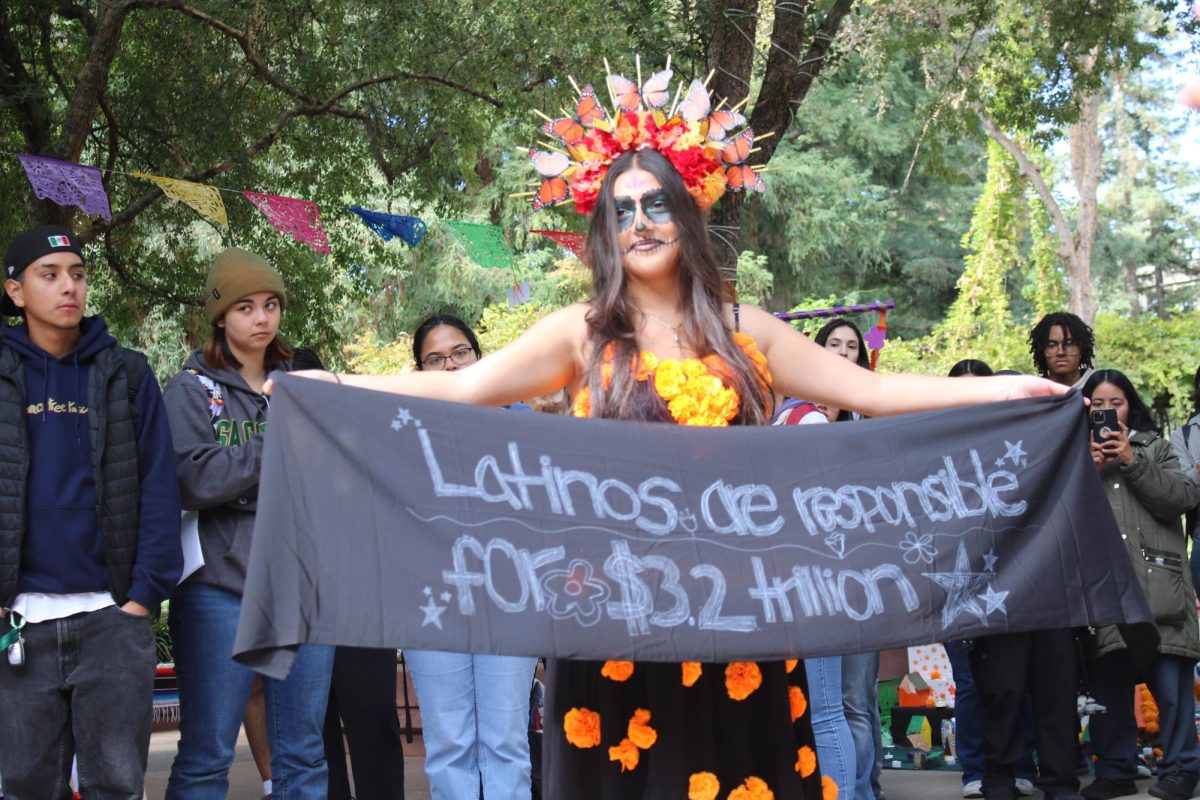The Barrio Arts & Ethnic Studies department held the fifth annual Día de los Muertos Communal Gathering celebration in the library quad on Wednesday, Oct. 30.
The first event was a Catrina fashion show which exhibited different cultural outfits put together by students. Flowers, photos, chalk and altars decorated the quad, honoring a new start for friends and family members who have died.
Día de los Muertos is not just a celebration of the dead, but a celebration with the dead. During the two-day holiday the dead briefly return to earth and are welcomed back with ofrendas. Ofrendas, or altars, are created in the dead’s honor using flowers, personal belongings, photos, water and sugar skulls.
Students from the Barrio Arts & Ethnic Studies department made their own ofrendas in honor of the holiday and displayed them in the Library Quad. Each ofrenda created by the students represented someone that died and was meaningful to them.
Students’ ofrendas not only highlighted Hispanic culture, but also brought awareness to victims of violence against people of color. One ofrenda paid tribute to missing and murdered Indigenous women, while another read “stop Asian hate” and put faces to the victims so they wouldn’t be forgotten.
First year mechanical engineering major Ishaq Sahan not only dedicated his ofrenda to the zoot-suit riots of 1943, but wore a zoot suit to represent those who died for wearing one.
According to History, Zoot suits were baggy, loose-form suits worn by young Mexican-Americans and other minorities in Los Angeles during World War ll. At the time, they were seen as a sign of delinquency and gang affiliation.
Despite Sahan’s ofrenda technically being a class project, it was so much more than that to him. Sahan said he specifically based his ofrenda on José Gallardo Díaz a man who was killed in the street and 17 bystanders were then arrested because of their zoot-suits.
“They were all arrested and tried for second degree murder, just because they were wearing the zoot suit during World War II when fabric was being rationed and it was seen as unpatriotic,” Sahan said. “They were all seen as gangsters and criminals and put in jail unfairly.”

Sahan was part of the Catrina fashion show, where students put together outfits related to La Catrina, the skeletal patterns often used in Día de los Muertos celebration and decoration. The outfits were centered around different cultural or historic themes.
“We researched La Catrina and our topic was basically Latino influence on US culture,” said sophomore health science major Vanessa Ortiz, who participated in the fashion show alongside some friends. “Our influence was [the film] Coco, so we recreated the characters from that.”
Other events included ofrenda storytelling and the marigold ceremony, when a pathway of flowers were laid throughout the library quad so that spirits could find their way home. For many students Día de los Muertos helped them feel closer to their culture, whether they celebrate yearly or not.
First year psychology major Carlos Gallardo said that celebrating Día de los Muertos and creating an ofrenda helped him connect with his roots.
RELATED: Día de Los Muertos art exhibit brings color to the afterlife
“As a Mexican and also as a first-generation Chicano, I feel closely connected to my culture,” Gallardo said. “I haven’t been to Mexico for a while and it gives me a closer connection with them.”
Gallardo dedicated his ofrenda to his friend who used to live in the same neighborhood as him before he passed away from cancer.
“He would always knock on my door asking me if I could play soccer with him in the street,” Gallardo said. “Unfortunately, I couldn’t anymore because [school] was giving me a bunch of homework. I started saying no.”
Once the COVID pandemic hit Gallardo rarely saw his friend, and after the cancer diagnosis the two couldn’t play soccer together anymore.
“I feel bad for all the times I said no,” Gallardo said. “If only I knew he was going to have cancer, I would have said yes and tried to make more memories with him.”

The Día de los Muertos event lasted all day, ending with students sharing the stories of those they honored their ofrendas to. For many, the celebration does more than just carry on the legacy of those who have passed. It helps people reconnect with their loved ones as if they were still there.
“We have family and friends that we loved and cared about who aren’t in the living world anymore,” Gallardo said. “They’re still living in our hearts and living in the world of the dead.”
Additional reporting by Madison Lopez and Sophia Vazquez.
























































































































